公司层策略(CorporateLevelStrategy).
- 格式:ppt
- 大小:341.00 KB
- 文档页数:34
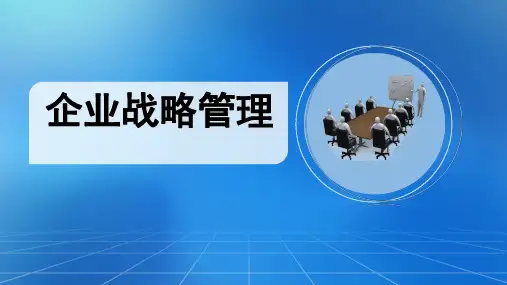
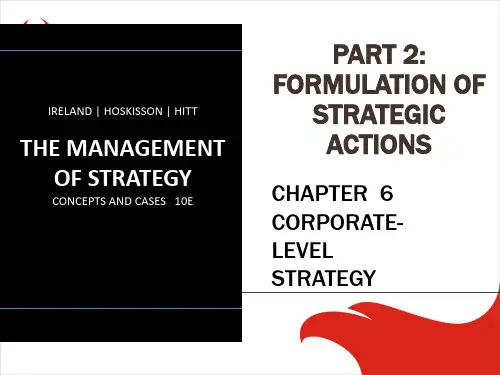
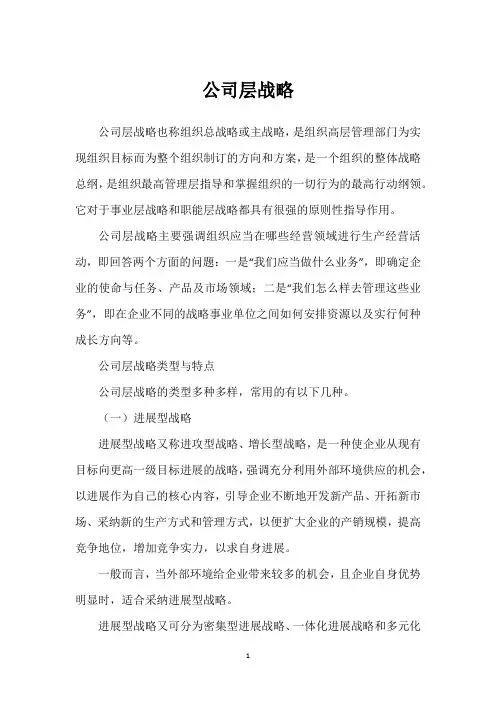
公司层战略公司层战略也称组织总战略或主战略,是组织高层管理部门为实现组织目标而为整个组织制订的方向和方案,是一个组织的整体战略总纲,是组织最高管理层指导和掌握组织的一切行为的最高行动纲领。
它对于事业层战略和职能层战略都具有很强的原则性指导作用。
公司层战略主要强调组织应当在哪些经营领域进行生产经营活动,即回答两个方面的问题:一是“我们应当做什么业务”,即确定企业的使命与任务、产品及市场领域;二是“我们怎么样去管理这些业务”,即在企业不同的战略事业单位之间如何安排资源以及实行何种成长方向等。
公司层战略类型与特点公司层战略的类型多种多样,常用的有以下几种。
(一)进展型战略进展型战略又称进攻型战略、增长型战略,是一种使企业从现有目标向更高一级目标进展的战略,强调充分利用外部环境供应的机会,以进展作为自己的核心内容,引导企业不断地开发新产品、开拓新市场、采纳新的生产方式和管理方式,以便扩大企业的产销规模,提高竞争地位,增加竞争实力,以求自身进展。
一般而言,当外部环境给企业带来较多的机会,且企业自身优势明显时,适合采纳进展型战略。
进展型战略又可分为密集型进展战略、一体化进展战略和多元化进展战略。
1.密集型进展战略密集型进展战略就是以高于以往的进展速度增加企业目前的产品或服务的销售额、利润和市场份额。
密集型进展战略包括市场渗透战略、市场开发战略和产品开发战略三种类型。
市场渗透战略就是企业利用原有市场上的优势,不断提高市场占有率和销售增长率。
市场开发战略就是企业在原有市场基础上不断开拓新市场,扩大产品销路。
产品开发战略就是企业通过不断改进老产品,开发新产品,以扩大产品销量。
2.一体化进展战略一体化进展战略就是企业充分利用自己在产品、技术、市场上的优势,在供产、产销方面实行纵向或横向联合,以扩大经营范围和经营规模的战略。
例如,当公司经营状况稳定时,通过自行生产其所需原材料或自行销售其产品的方式来增加收益。
一体化进展战略分为横向一体化和纵向一体化。
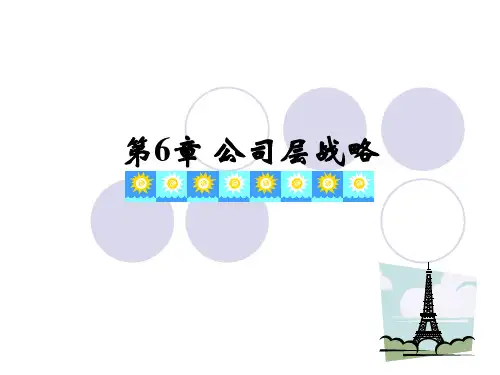
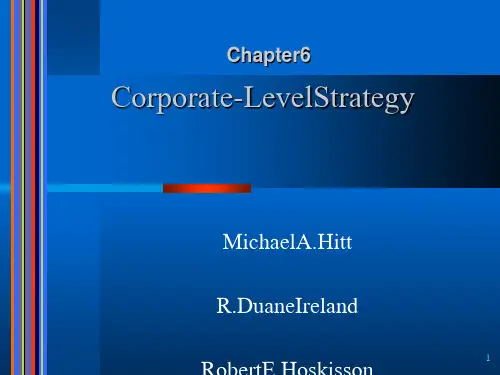
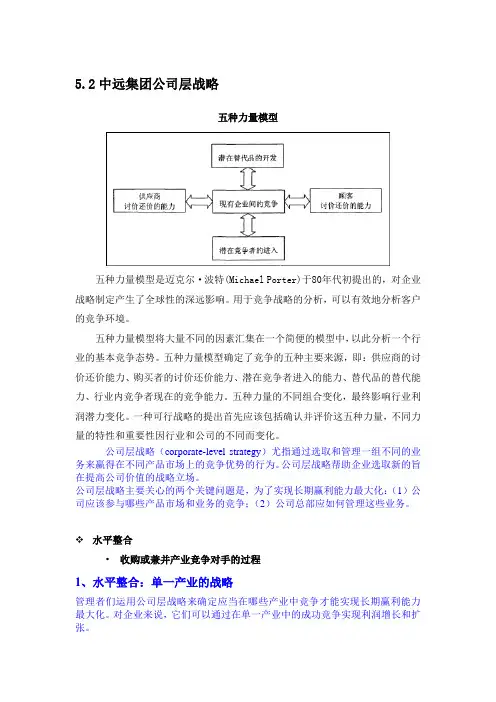
5.2中远集团公司层战略五种力量模型五种力量模型是迈克尔·波特(Michael Porter)于80年代初提出的,对企业战略制定产生了全球性的深远影响。
用于竞争战略的分析,可以有效地分析客户的竞争环境。
五种力量模型将大量不同的因素汇集在一个简便的模型中,以此分析一个行业的基本竞争态势。
五种力量模型确定了竞争的五种主要来源,即:供应商的讨价还价能力、购买者的讨价还价能力、潜在竞争者进入的能力、替代品的替代能力、行业内竞争者现在的竞争能力。
五种力量的不同组合变化,最终影响行业利润潜力变化。
一种可行战略的提出首先应该包括确认并评价这五种力量,不同力量的特性和重要性因行业和公司的不同而变化。
公司层战略(corporate-level strategy)尤指通过选取和管理一组不同的业务来赢得在不同产品市场上的竞争优势的行为。
公司层战略帮助企业选取新的旨在提高公司价值的战略立场。
公司层战略主要关心的两个关键问题是,为了实现长期赢利能力最大化:(1)公司应该参与哪些产品市场和业务的竞争;(2)公司总部应如何管理这些业务。
水平整合•收购或兼并产业竞争对手的过程1、水平整合:单一产业的战略管理者们运用公司层战略来确定应当在哪些产业中竞争才能实现长期赢利能力最大化。
对企业来说,它们可以通过在单一产业中的成功竞争实现利润增长和扩张。
在追求水平整合的过程中,管理者们决定将企业的资本投资于购买产业竞争对手的资产,从而提高其商业模式的赢利能力。
水平整合提高利润和赢利能力的原因是:(1)削减成本;(2)提高产品差异化;(3)复制商业模式;(4)减少产业内部的竞争;(5)增加对供应商和购买者的讨价还价的力度。
●1988年8月26日,中远总公司与南通港务局签署南通船厂并入中远总公司的协议。
同年12月,中远总公司正式接收南通船厂。
1988年11月29日,中远总公司收购“中好船务代理有限公司”英方股份,使之成为中远在英国的独资公司,并于1989年8月18日更名为“中远(英国)有限公司”。
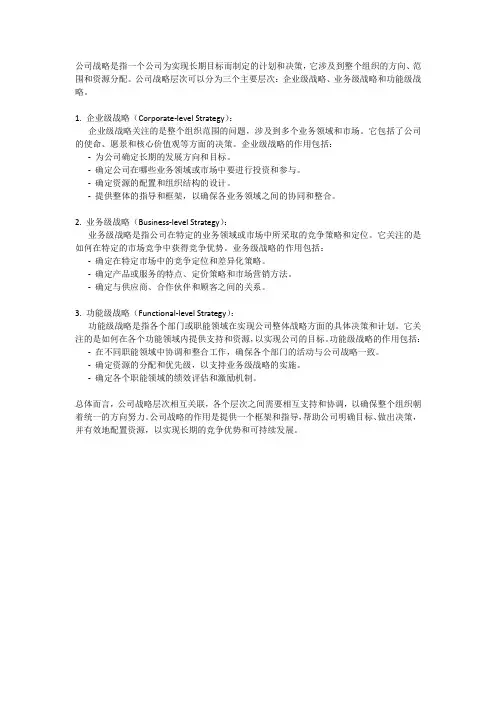
公司战略是指一个公司为实现长期目标而制定的计划和决策,它涉及到整个组织的方向、范围和资源分配。
公司战略层次可以分为三个主要层次:企业级战略、业务级战略和功能级战略。
1. 企业级战略(Corporate-level Strategy):企业级战略关注的是整个组织范围的问题,涉及到多个业务领域和市场。
它包括了公司的使命、愿景和核心价值观等方面的决策。
企业级战略的作用包括:-为公司确定长期的发展方向和目标。
-确定公司在哪些业务领域或市场中要进行投资和参与。
-确定资源的配置和组织结构的设计。
-提供整体的指导和框架,以确保各业务领域之间的协同和整合。
2. 业务级战略(Business-level Strategy):业务级战略是指公司在特定的业务领域或市场中所采取的竞争策略和定位。
它关注的是如何在特定的市场竞争中获得竞争优势。
业务级战略的作用包括:-确定在特定市场中的竞争定位和差异化策略。
-确定产品或服务的特点、定价策略和市场营销方法。
-确定与供应商、合作伙伴和顾客之间的关系。
3. 功能级战略(Functional-level Strategy):功能级战略是指各个部门或职能领域在实现公司整体战略方面的具体决策和计划。
它关注的是如何在各个功能领域内提供支持和资源,以实现公司的目标。
功能级战略的作用包括:-在不同职能领域中协调和整合工作,确保各个部门的活动与公司战略一致。
-确定资源的分配和优先级,以支持业务级战略的实施。
-确定各个职能领域的绩效评估和激励机制。
总体而言,公司战略层次相互关联,各个层次之间需要相互支持和协调,以确保整个组织朝着统一的方向努力。
公司战略的作用是提供一个框架和指导,帮助公司明确目标、做出决策,并有效地配置资源,以实现长期的竞争优势和可持续发展。
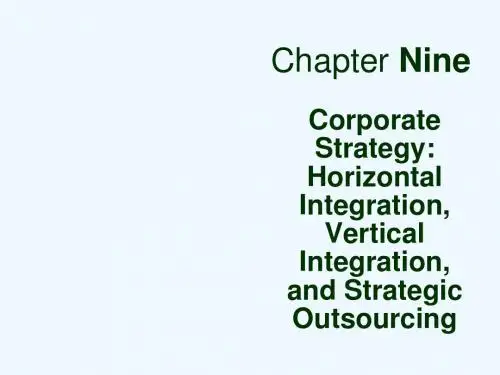
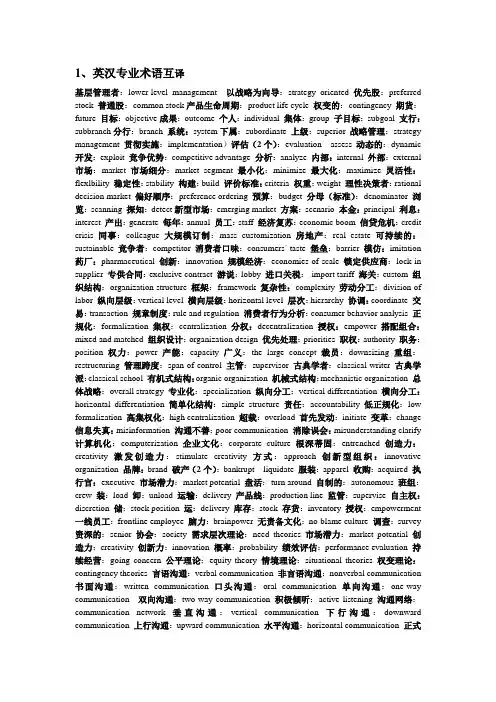
1、英汉专业术语互译基层管理者:lower-level management 以战略为向导:strategy oriented 优先股:preferred stock 普通股:common stock产品生命周期:product life cycle 权变的:contingency期货:future 目标:objective成果:outcome 个人:individual集体:group 子目标:subgoal 支行:subbranch分行:branch系统:system下属:subordinate 上级:superior 战略管理:strategy management 贯彻实施:implementation)评估(2个):evaluation assess动态的:dynamic 开发:exploit 竞争优势:competitive advantage 分析:analyze 内部:internal 外部:external 市场:market 市场细分:market segment 最小化:minimize最大化:maximize 灵活性:flexlbility 稳定性:stability构建:build 评价标准:criteria 权重:weight 理性决策者:rational decision market 偏好顺序:preference ordering 预算:budget 分母(标准):denominator 浏览:scanning探知:detect新型市场:emerging market 方案:scenario 本金:principal 利息:interest产出:generate 每年:annual 员工:staff 经济复苏:economic boom 信贷危机:credit crisis 同事:colleague 大规模订制:mass customization房地产:real estate 可持续的:sustainable 竞争者:competitor 消费者口味:consumers` taste 堡垒:barrier模仿:imitation 药厂:pharmaceutical创新:innovation规模经济:economies of scale 锁定供应商:lock in supplier 专供合同:exclusive contract游说:lobby 进口关税:import tariff 海关:custom 组织结构:organization structure 框架:framework 复杂性:complexity 劳动分工:division of labor 纵向层级:vertical level 横向层级:horizontal level 层次:hierarchy 协调:coordinate 交易:transaction 规章制度:rule and regulation 消费者行为分析:consumer behavior analysis 正规化:formalization集权:centralization 分权:decentralization 授权:empower 搭配组合:mixed and matched 组织设计:organization design 优先处理:priorities 职权:authority职务:position权力:power 产能:capacity 广义:the large concept裁员:downsizing重组:restructuring 管理跨度:span of control 主管:supervisor 古典学者:classical writer 古典学派:classical school 有机式结构:organic organization 机械式结构:mechanistic organization 总体战略:overall strategy专业化:specialization 纵向分工:vertical differentiation 横向分工:horizontal differentiation 简单化结构:simple structure责任:accountability 低正规化:low formalization 高集权化:high centralization超载:overload 首先发动:initiate 变革:change 信息失真:misinformation 沟通不善:poor communication 消除误会:misunderstanding clarify 计算机化:computerization企业文化:corporate culture根深蒂固:entrenched 创造力:creativity 激发创造力:stimulate creativity 方式:approach 创新型组织:innovative organization 品牌:brand 破产(2个):bankrupt liquidate服装:apparel 收购:acquired 执行官:executive市场潜力:market potential 盘活:turn around 自制的:autonomous 班组:crew 装:load卸:unload 运输:delivery 产品线:production line监管:supervise 自主权:discretion储:stock position 运:delivery 库存:stock存货:inventory 授权:empowerment 一线员工:frontline employee 脑力:brainpower 无责备文化:no-blame culture 调查:survey 资深的:senior 协会:society 需求层次理论:need theories市场潜力:market potential 创造力:creativity 创新力:innovation 概率:probability 绩效评估:performance evaluation 持续经营:going concern 公平理论:equity theory情境理论:situational theories 权变理论:contingency theories 言语沟通:verbal communication 非言语沟通:nonverbal communication 书面沟通:written communication 口头沟通:oral communication 单向沟通:one-way communication 双向沟通:two-way communication积极倾听:active listening 沟通网络:communication network 垂直沟通:vertical communication 下行沟通:downward communication 上行沟通:upward communication 水平沟通:horizontal communication 正式沟通:formal communication 非正式沟通 informal communication 纠正行为 corrective action 机制:mechanisms 资源resource 来源:source 外包:outsourcing 流动资产:current asset 固定资产:fixed asset 流动负债:current liabilities 长期负债:long-term liabilities 股票:stockholder 利益相关者:stakeholder 利息:interest 利率:interest rate 所得税:income tax 增值税:valueadded tax KA (主要客户):key account 财务报表:financial statement 资产负债表:balance sheet 预算:budgeting 原材料:raw materials 在制品:work-in-process 成品:finished-goods 半成品:semi-finished goods二、缩写词1、R&D :Research and Development2、ISO :International Standardization Organization3、MBO :Management By Objective4、SWOT :s trengths, weaknesses, opportunities and threats.5、TQM :Total Quality Management6、MIS :M anagement Information System7、M&A :Merge And Acquisition 8、SCM :Supply Chain Management9、CEO :chief executive officer 10、CFO :C hief Financial Officer 11、JIT :just in time12、HRM :Human Resource Management 13、ERP :Enterprise Resource Plan14、SWIFT: Society for Worldwide Interbank Financial Telecommunication15、EOQ :economical ordering quantity 16、ROI :return on investment三、简答1、SWOT 分析The term SWOT analysis refers to analyzing the organization`s internal strengths and weaknesses as well as external opportunities and threats in order to identify a niche that the organization can exploit2、BCG 矩阵The BCG matrix identifies four business group :stars cash cows question marks and dogs3、五力分析模型4、公司的竞争战略1)公司层战略 corporate-levelstrategy (1)stability strategy (2)growth strategy (3)retrenchment strategy (4)combination strategy2)事业层战略 business-level strategy(1)adaptive strategy (2)competitive strategyCompetitive strategy 竞争性战略:1)over-all cost strategy 2)differentiation strategy3)focus strategy3)职能层战略 functional-level strategy5、职权的结构Authority structure1)coercive power 2)reward power6、部门化的方式departmentalization1) Customer departmentalization 2) Functional departmentalization 3) Geographic departmentalization 4) Process departmentalization 5) Product departmentalization7、组织结构类型Organization structure1) Mechanistic organization (1) Linear structure (2) Functional structure (3) Matrix structure (4) Network structure (5) Simple structure2) Organic structure8、马斯洛需求层次理论Hierarchy of needs theory1)Physiological needs 2)Safety needs 3)Belongingness needs 4)Esteem needs5)Self-actualization needs9、双因素理论two-factor theory 1) motivator 2)hygiene factor激励因素:1)process theories 2)content theories10、强化理论reinforcement theory 1)positive reinforcement 2)negative reinforcement11、期望理论的内容Expectancy theory1)effort-performance expectancy 2) performance-outcome expectancy12、管理的三种方式1)autocratic 2)democratic 3)lasissez-faire13、管理方格图the management grid1) employee-centered 2)job-centered 3)production-centered14、五种常见沟通网络five kind of communication network1)wheel network 2)chain network 3)Y network 4)circle network 5)star network15、沟通网络图1)sender 2)encoding process 3)medium 4)decoding 5)noise 6)feedback16、责任中心的五种类型:five type of responsibility center1)standard cost center 2)revenue center 3)profit center 4)investment center17、管理者的权力结构18、控制control 1)feedforward control 2)concurrent control 3)feedback control19市场控制market control 1)overcontrol 2)undercontrol20、会计的六要素:six accounting elementsassets liabilities woners` equity revenues expenses profits21、管理者的权利结构manager`s power structure1)referent power 2)expert power 3)authority四、论述What Managers DoThe successful manager capably performs four basic managerial funcations :planning,organizing,leading,and controlling. However as you will see,the amount of time a manager spends on each function depends on the level of the particular job.Planning. In general ,planning involves defining organizational goals and proposing ways to reach them. Managers plan for three reason to establish an overall direction for the organization`s future , to identify and commit the organization`s resources to achieving its goals and to decide which tasks must be done to each those goalsOrganizing. Organizing is the process of creating a structure of relationships that will enable employees to carry out management`s plans and meet organizational goalsLeading. Leading involves communicating with and motivating others to perform the tasks necessary to achieve the organization`s goalsControlling. The process by which a person ,group ,or organization consciously monitors performance and takes corrective action is controllingWe use these function to help explain exactly how managers do their jobs。
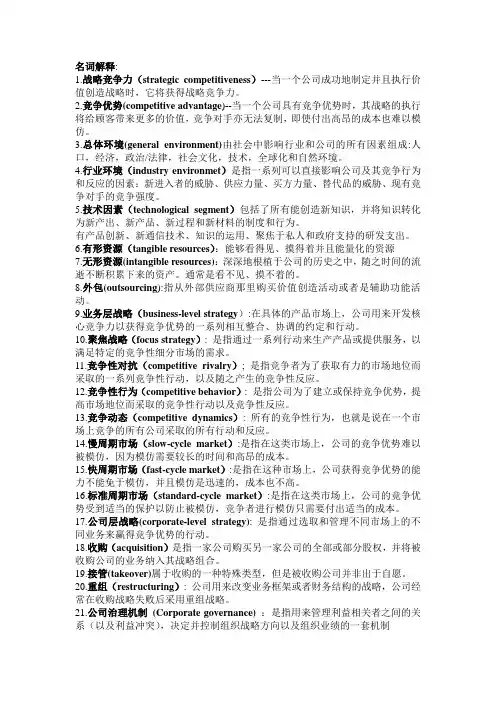
名词解释:1.战略竞争力(strategic competitiveness)---当一个公司成功地制定并且执行价值创造战略时,它将获得战略竞争力。
2.竞争优势(competitive advantage)--当一个公司具有竞争优势时,其战略的执行将给顾客带来更多的价值,竞争对手亦无法复制,即使付出高昂的成本也难以模仿。
3.总体环境(general environment)由社会中影响行业和公司的所有因素组成:人口,经济,政治/法律,社会文化,技术,全球化和自然环境。
4.行业环境(industry environmet)是指一系列可以直接影响公司及其竞争行为和反应的因素:新进入者的威胁、供应力量、买方力量、替代品的威胁、现有竞争对手的竞争强度。
5.技术因素(technological segment)包括了所有能创造新知识,并将知识转化为新产出、新产品、新过程和新材料的制度和行为。
有产品创新、新通信技术、知识的运用、聚焦于私人和政府支持的研发支出。
6.有形资源(tangible resources):能够看得见、摸得着并且能量化的资源7.无形资源(intangible resources):深深地根植于公司的历史之中,随之时间的流逝不断积累下来的资产。
通常是看不见、摸不着的。
8.外包(outsourcing):指从外部供应商那里购买价值创造活动或者是辅助功能活动。
9.业务层战略(business-level strategy):在具体的产品市场上,公司用来开发核心竞争力以获得竞争优势的一系列相互整合、协调的约定和行动。
10.聚焦战略(focus strategy):是指通过一系列行动来生产产品或提供服务,以满足特定的竞争性细分市场的需求。
11.竞争性对抗(competitive rivalry);是指竞争者为了获取有力的市场地位而采取的一系列竞争性行动,以及随之产生的竞争性反应。
12.竞争性行为(competitive behavior):是指公司为了建立或保持竞争优势,提高市场地位而采取的竞争性行动以及竞争性反应。
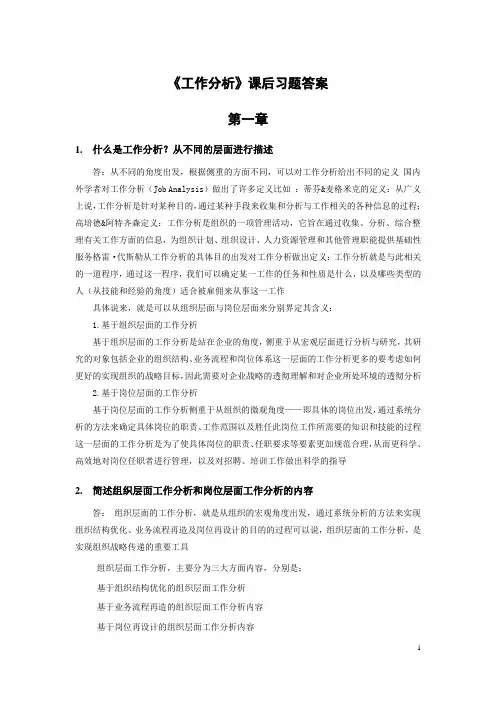
《工作分析》课后习题答案第一章1.什么是工作分析?从不同的层面进行描述答:从不同的角度出发,根据侧重的方面不同,可以对工作分析给出不同的定义国内外学者对工作分析(Job Analysis)做出了许多定义比如:蒂芬&麦格米克的定义:从广义上说,工作分析是针对某种目的,通过某种手段来收集和分析与工作相关的各种信息的过程;高培德&阿特齐森定义:工作分析是组织的一项管理活动,它旨在通过收集、分析、综合整理有关工作方面的信息,为组织计划、组织设计、人力资源管理和其他管理职能提供基础性服务格雷·代斯勒从工作分析的具体目的出发对工作分析做出定义:工作分析就是与此相关的一道程序,通过这一程序,我们可以确定某一工作的任务和性质是什么,以及哪些类型的人(从技能和经验的角度)适合被雇佣来从事这一工作具体说来,就是可以从组织层面与岗位层面来分别界定其含义:1.基于组织层面的工作分析基于组织层面的工作分析是站在企业的角度,侧重于从宏观层面进行分析与研究,其研究的对象包括企业的组织结构、业务流程和岗位体系这一层面的工作分析更多的要考虑如何更好的实现组织的战略目标,因此需要对企业战略的透彻理解和对企业所处环境的透彻分析2.基于岗位层面的工作分析基于岗位层面的工作分析侧重于从组织的微观角度——即具体的岗位出发,通过系统分析的方法来确定具体岗位的职责、工作范围以及胜任此岗位工作所需要的知识和技能的过程这一层面的工作分析是为了使具体岗位的职责、任职要求等要素更加规范合理,从而更科学、高效地对岗位任职者进行管理,以及对招聘、培训工作做出科学的指导2.简述组织层面工作分析和岗位层面工作分析的内容答:组织层面的工作分析,就是从组织的宏观角度出发,通过系统分析的方法来实现组织结构优化、业务流程再造及岗位再设计的目的的过程可以说,组织层面的工作分析,是实现组织战略传递的重要工具组织层面工作分析,主要分为三大方面内容,分别是:基于组织结构优化的组织层面工作分析基于业务流程再造的组织层面工作分析内容基于岗位再设计的组织层面工作分析内容岗位层面工作分析的内容包括如下六个方面:此项工作做什么(What)为何要完成此工作(Why)工作何时做(When)工作在哪里做(Where)如何完成工作(How)完成工作需要哪些条件(Which)3.工作分析在我国的应用中存在那些问题?如何解决答:工作分析这门科学进入我国的时间比较晚,从建国后才被正式引进,而且由于国情因素,工作分析在我国的发展速度并不快,直至90年代后才开始逐渐开始受到重视并步上正规90年代前,工作分析在我国的发展并不正规其中最具有代表意义的即为我国纺织业职位评价体系及劳动规范的建立和国企岗位责任制的建立上个世纪90年代以后,随着改革开放的不断深化,社会主义市场机制的顺利发展,在不断涌现的民营企业和不断进入我国的外国企业的冲击下,市场竞争激残酷的时期在这种企业外部的环境瞬息万变的情况下,中国的本土老牌国企纷纷受到了严峻的挑战,在他们面前的,已经不仅仅是能够继续独领风骚的问题,更多的是能否生存的考验在这种情势下,工作分析受到了众多国企的重视,被视为救命稻草,纷纷被引进到企业当中1、工作分析脱离企业战略2、工作分析缺乏明确的目标导向3、工作分析缺乏与流程的衔接4、工作分析缺乏相关人员的支持与配合5、工作分析的客体不正确6、工作分析方法技术不合理、不科学7、缺乏及时应用和动态管理工作分析的成果文件西方企业的工作分析已经日趋模糊化,因为它们早期已经通过工作分析建立了非常规范的职位管理制度,而此时它们更需要做的是为应对激烈的竞争而合并职位以及建立团队,并制定灵活的角色(作用)说明书而在国内企业中,工作分析这一人力资源管理体系的基石还没有奠定牢固,因此,国内企业不能盲目学习西方企业的管理方式,国内企业首先要做的,就是做好、做实工作分析,为其他人力资源活动奠定牢固的基础4.应用案例题1.现在这家公司的工作分析存在那些问题?分析思路:没有结合公司的发展战略进行分析;职位说明书描述过于定性化,过于简单、粗浅;没有人员要求的描述;工作分析的角度过于简化,只从工作本身进行2.如果你是小西,你会如何完成这项棘手的工作分析工作呢?分析思路:做好工作分析的计划:充分的沟通,与公司高层领导的沟通,分析公司的发展战略和方向,还需要与员工的沟通;准备做好组织层面和岗位层面的工作分析,落实工作分析的内容;协调需要的人员和需要的资源,有必要的时候需要同事的帮忙或者外请专家和咨询服务第二章组织层面工作分析概述5.组织层面工作分析的内涵是什么?对企业有哪些方面的作用?组织层面工作分析(Job Analysis Based on Organization),不同于某个具体岗位层面的工作分析,侧重于站在企业的角度从宏观层面进行分析与研究,包括企业的组织结构、业务流程、岗位体系三个主要研究对象组织层面工作分析对企业有如下两方面作用:(一)实现战略传递(二)提高企业竞争力6.战略主要分为哪些不同层面?各层面具体包含什么内容?请举例说明一般来讲,企业的战略主要包括三个层面:公司层面、业务层面和职能层面的战略1.公司层面的战略(corporate-level strategy)公司层面的战略主要描述一个公司的总体方向,关注的是公司的整体目标和活动范围及如何增加公司各个不同部门(业务单位)的价值2.业务层面的战略(business-level strategy)业务层面的战略涉及到与每个业务单元相适合的各种决策和行动,业务战略的主要目标是使部门在它所面对的市场上更具竞争力3.职能层面的战略(Function-level strategy)职能层面的战略主要是指组织内的各个职能部分如何有效地利用组织资源、流程和人员,通过最大化公司的资源产出率来支持公司层面的战略和业务层面的战略7.试分析战略与组织层面工作分析的相互关系(一)战略与组织的关系任何企业在确定了其使命、愿景和战略的基础上,必须使其在组织和管理上得以有效的落实与传递因此,组织就成为在企业的目标系统与人力资源管理系统之间进行衔接的桥梁和纽带企业为了能在市场中获得并保持竞争优势,需要不断进行改革与创新,优化组织形式以应对不断发生的变化(二)战略与流程的关系战略是一个组织长期的发展方向和范围,它通过在不断变化的环境中调整资源配置以获取竞争优势在这个逐步发展的过程中,流程是战略实现的重要基石,承载着发展企业的重要使命它根据企业的发展战略来构建企业的业务流向,是战略达成的重要保障没有流程的支持,企业战略将无法实现(三)战略与岗位体系战略对组织、流程的决定作用直接决定了企业的岗位设置岗位是承载企业战略的最小单元,它呈现着企业为达成战略所需要承担的各项具体的工作战略的变化会改变企业的业务项目、业务深度、业务重要性等方面,最终通过岗位的增减、工作内容的变化等方面加以体现若企业的战略进行调整后,没有及时对岗位体系进行相应的改变,那么企业将难以实现既定的战略,更可能产生阻碍作用,威胁企业的发展甚至生存8.应用案例分析思路:启示:(1)战略对组织的重要影响;(2)组织结构调整对提高企业竞争力的重要作用;(3)产业链下企业效益的提升;(4)国际化竞争力与规模效应2、(1)分析国际竞争为人力资源管理提供的机遇和挑战;机遇:劳动力成本的转移;不同文化对组织、人员适应性的锻炼与提升;挑战:文化冲击对人力资源管理的影响;跨地域法律制度、相关法规的融合与平衡;不同发展阶段、不同市场机遇对企业管理水平、管控程度的要求;(2)分别从组织结构、流程、人员配备等方面进行深入分析第三章基于组织结构优化的组织层面工作分析9.企业什么时候需要进行组织结构优化?在现实情况下,企业需要进行组织优化可以归结为以下两种情况:(一)企业自身陷入“困境”这个“困境”,实际上可以体现为两种可能:一是现有的组织结构存在较大的问题;二是企业已然驻足不前,希望通过进行组织结构的局部调整和完善达成企业发展的目标(二)企业状况良好、期望飞越企业的管理者从更长远的角度考虑,希望通过组织结构优化达成企业的战略愿景,加大、加快企业前进的步伐,使企业能够提高到另外一个层次,发生质的飞越10.如何对组织结构进行诊断?组织结构通常会存在哪些问题?我们通常是从组织结构对企业贡献的这个角度来进行组织结构诊断的从对企业贡献的角度考虑,具体的贡献可以通过组织结构对企业价值创造所起到的功能大小来衡量,所有的功能可以概括为三个方面:效能、效率与安全效能是指实际产出与预期产出地比例,效率是指实际产出与实际投入的比例,安全则是现在对未来的投资组织结构通常会出现如下常见问题:1.部门定位不清晰2.结构设计不合理3.因人设岗现象较为严重4.权责设计不匹配11.简述企业实施组织结构优化的实施步骤组织优化的过程与内容与组织设计的过程与内容有所相似,主要区别在于前者是一种针对性调整,需要组织不断地根据战略的变化而进行改变、优化,使之与组织战略相适应具体地讲,组织优化的程序和内容可以归结为以下几个步骤:(一)确定组织优化的目的(二)职能分解与优化(三)组织结构框架优化(四)纵、横向管控、协调关系的确立(五)运行保障调整(六)反馈和修正12.一般情况下,企业实施组织结构优化需要注意哪些问题?具体的对策是什么?(一)组织优化的过渡性为了避免优化方案的难以实施或是不同程度的妥协与修改,在进行组织优化时,有必要设计一个过渡性或试运转的组织,特别是当优化的方案有较大变革时,往往因各种原因而使现有的组织无法进行结构的转换在过渡组织中,不能出现与优化方案相矛盾或是在优化目的上做重大修改的临时措施(二)组织结构中的人性因素人在组织结构中是处处受到限制的职位、部门、管理规范、规章制度、流程等等方面都对人加以制约如何使组织对人的限制与人的需要在组织中的满足相结合,是进行组织结构优化过程中需要考虑的重要方面(三)组织结构的合适性每个企业在进行组织结构优化时,都会参考标杆企业的组织结构设置模式,尤其会参照那些由于组织结构出众为企业带来巨大贡献的组织模式借鉴是有利的,它可以为企业提供一种崭新的思考角度,但是一味的照猫画虎、依葫芦画瓢只能学到表象,无法获得其精髓因此,企业需要找到最适合自身状况的部分加以借鉴,并根据自我特点进行适当的调整,以满足个性的需要13.为降低外部环境不确定性对企业内部运营的冲击与干扰,企业组织应如何应对?可以考虑增强组织的弹性以加强组织的适应性,尤其强调受外部环境影响较大的组织设计;同时,加强对企业组织的动态化、持续化管理,通过制度等方面的有效保障以最大程度降低组织因环境骤变而受到的冲击14.应用案例分析思路:1、失败的原因:(1)在进行组织结构优化前没有进行足够细化的前期分析;(2)凡实施大的组织变革应注意过渡方案的设计,不易进行“休克疗法”;(3)应针对不同的利润中心,对市场竞争程度进行细化分析,根据不同市场采取不同的运作模式,不可“一刀切”2、不同意不是每次组织结构的调整都为企业的发展等方面提供可能,若组织未能审时度势、有针对性、过渡性的进行优化,那么不仅连可能性也没有,甚至可能适得其反,正如案例所示,结合第一问,进一步扩展阐述第四章基于业务流程再造的组织层面工作分析15.什么是流程再造?它对企业的价值是什么?业务流程再造,是美国人汉默(Hammer)和钱匹(Champy)在1993年提出来的,是指以业务流程为改造对象和中心、以客户需求和满意度为目标、对现有业务流程进行根本的再思考和彻底的再设计,利用先进的制造技术、信息技术以及现代化的管理手段,最大限度地实现技术上的功能集成和管理上的职能集成,以打破传统的职能型组织结构,建立全新的过程型组织结构,从而实现企业在经营成本、质量、服务和速度等方面的巨大改善本书的业务流程再造的涵义,主要侧重于对企业现有流程的一种再造,是一种系统化改造法,通过分析理解企业的现有流程,提出相应的再造方案,进而达到优化流程、提高绩效的目的对企业而言,高效的业务流程再造有利于整合跨职能流程、强化并提升与客户满意度有关的业务流程、强化企业风险管理和降低业务流程及相关成本16.什么样的企业需要进行业务流程再造?一般情况下,需要实施BPR项目的企业大体可分成如下三类:(一)积重难返的企业这类企业身陷困境、走投无路,期望借助一套突破性的管理改进方案,冲出困境、柳暗花明(二)状况一般的企业存在潜在风险,适时的推行业务流程再造,以改进企业薄弱环节,提高企业整体素质和综合竞争力(三)辉煌时刻的企业希望企业能够通过实施业务流程再造,勇攀高峰,再创新的辉煌17.如何进行现有业务流程的诊断?(一)关键业务流程的选择在进行业务流程诊断之前,首先要甄选关键业务流程,这是实施业务流程再造的基本命题和首要、关键的问题在进行关键业务流程的选择时,重点关注企业跨职能部门的业务流程、绩效低的流程、对客户满意度的影响程度高的流程以及具备可行性的流程,具体可采用的方法包括:绩效表现-重要性矩阵,流程优先矩阵,成本-收益矩阵,学习五角星法(二)发现、研究现有流程存在的问题寻找现有流程存在的问题以及问题发生的根源,主要采用的“病症”诊断方法包括鱼骨分析法、标杆法、基于活动的成本分析方法、质量功能展开、时间动作研究、帕累托图18.简述业务流程再设计的方法和步骤(一)业务流程再造的步骤1、在业务流程诊断的基础上,针对流程存在的问题提出主要的变更建议2、经过高层领导者通过后,拟定新的业务流程方案3、当新流程方案拟定且描述后,对拟订的方案进行验证4、试点结束后,企业就需要将优化后的新流程逐步引入实施,在企业中逐步推广(二)业务流程再造的方法在进行业务流程再造时,可采用所谓的ESIA (E:eliminate,消除;S:simply,简化;I: integrate,整合;A: automate,自动化)方法使用这种方法应当在取得对待设计流程的理解之后,依次针对ESIA的每个方面列出所有可能改进的清单,让所有人员通过讨论会的形式各抒己见、献计献策,在大家达成共识的基础上设计出新流程19.如何用流程增值分析模型实施流程的评估?流程增值分析模型是在波特的企业价值链模型思想的指导下,对流程中每一项作业活动进行增值分析的工具它的最主要用途是区别作业活动是否为企业增值的环节,并根据作业的增值属性将作业分为增值作业和非增值作业增值作业(Value-added Activity)是指能为顾客增加价值的作业活动,非增值作业(Non Value-added Activity)就是那些无法增加顾客价值的作业活动企业是通过为顾客提供产品和服务获得利润若企业完成业务流程再造后,非增值作业的比例增加,或者是原本预计消除的非增值作业活动没有得以消除或改善,那么业务流程再造的效果必然不会像我们事先预计的那样,效率的提高幅度也会大打折扣甚至降低需要注意的时,对于企业中存在的各种非增值活动,并不能一视同仁有些非增值活动的存在,确保了流程本身的有序性,为流程的正常运转起支持作用,不能随意进行删减因此,在进行流程增值分析过程时,企业需要对发现的非增值活动做进一步分析,力争把无效的非增值作业活动数量最小化20.应用案例分析思路:1、成功的主要因素:(1)选择了恰当的时机,做战略调整下的灵活应对;(2)为迅速应对市场采取了以市场链为纽带的组织形式,大幅提高工作效率;(3)注重流程、结构变化下员工理念的转变、素质的提升2、学习到了:企业在做业务流程再造过程中时机选择、方式转变等方面的经验;充分了解企业在战略调整下的分析与抉择第五章基于岗位再设计的组织层面工作分析21.岗位再设计的含义是什么?岗位再设计是为了配合组织优化和业务流程再造的需要,按照一定的原则,在已有岗位的基础上对岗位进行重新设计的动态过程22.岗位再设计的内容是什么?岗位再设计的内容就是在岗位再设计的过程中应该涉及到的各个方面,包括三个方面:工作内容、岗位职责和工作关系工作内容主要包括工作的广度、深度、完整性、自主性和反馈性岗位职责主要包括岗位责任、权利、工作方法、相互沟通和合作工作关系主要体现为协作、监督等关系23.岗位再设计的原则是什么?岗位再设计主要遵循一下原则:系统原则、因事设岗原则、整分合原则、最少岗位数原则、规范化原则、动静结合原则、能级原则、一般性原则和客户导向原则24.岗位再设计应考虑哪些因素?一个成功有效的岗位再设计,需要综合考虑的因素较多,具体来讲包括如下七个因素:组织的目标和功能、组织结构、工作流程、技术/工艺/设备的要求、工作环境、工作时间以及对人员的开发与激励25.岗位设置诊断的内容是什么?(1)组织内是否存在职能职责的缺失或重叠;(2)组织内人员与岗位是否能合理匹配;(3)组织内人员发展问题26.岗位设置的常见问题及对策是什么?企业中一般都会存在以下几种不应该出现的违反岗位设置原则的情况:(1)多头领导;(2)副职设置过多;(3)岗位交叉、重叠;(4)以技术岗位或业务代替行政管理岗位;(5)缺少岗位晋升路线对策:(1)针对管理层次过少导致管理幅度过大,企业可以设中间层管理人员实现上传下达,做好上下级之间的沟通;(2)针对企业的部门职能划分不合理、组织结构不健全情况,企业应该对各个职能进行分析,把相近的职能划分到一个部门,性质不同的职能放在不同的部门;(3)针对组织职责不清问题,企业在进行分析的基础上,严格界定各部门的职能,明确各部门的职责对于职责过多问题,要在任务完成的前提下,对各部门的职能进行平衡,对于任务过多的部门可以考虑另设新的部门,将其中一部分职能分解出来;(4)针对组合子的业务流程不合理的问题,企业在科学分析的基础上按照流程精简的原则,对其进行岗位改进或重塑,通过改变作业或服务的顺序,减少流程周转时间;(5)针对岗位设置不合理和岗位职责不清的问题,企业在分析的基础上对不合理的岗位进行重新设置或撤消,明确各个岗位的职责和权限;(6)针对员工对自己的工作职责、权限和职位晋升路线不明确的问题,企业应该建立明确的层次结构图27.岗位再设计的方法主要有哪些?从方法论上可以概括为传统的岗位再设计方法、激励型的岗位再设计方法和人性化的岗位再设计方法三类传统的岗位再设计方法包括机械型岗位再设计方法、生物型岗位再设计方法和知觉运动型岗位再设计方法激励型的岗位再设计方法包括:工作轮换、工作扩大化和工作丰富化人性化的岗位再设计方法包括自主性工作团队、工作生活质量和灵活的工作时间制度28.应用案例分析思路:1、说明:充分体现出在进行岗位再设计过程中的人性化设计、激励型设计的重要性和优越性2、启发:(1)如何在注重人性化设计的同时对人员进行有效的管理,寻求到粗放与细化管理的平衡点;(2)团队作业中考核的难度如何进行有效的控制?针对每个人又如何进行细化的量化考核?(3)如何有效控制劳动力成本?第六章29.在何种情况下需要进行工作分析?答:对于一个组织来说,当组织发生重大变革的时候,为了保证组织能够继续的健康发展,有必要对组织实施工作分析这里所说的重大变革,可以分为如下几类:1.组织体制上的变革当组织由于国家政策导向要求,或者出于自身为了适应外部环境、希望更好的生存下去的目的而不得不进行体制改革的时候——比如中国的国有企业体制改革等,组织应该进行工作分析因为随着组织体制的转变,组织的一系列工作要素都将发生重大改变如果不及时进行工作分析而实现良性调整,或者只是追求形式上的转变,那么改革不仅对于组织无益,还可能带来严重的负面影响2.组织结构上的变革当组织内部根据战略调整或者业务流程的变化需要而建立了新的部门,或者对原有部门设置进行了局部的调整的时候;应该进行工作分析这是因为,随着组织结构的变化,组织内部各个岗位的工作内容、方法与职责都有可能或多或少的产生改变,如果继续沿用旧有的工作内容与工作规范的话,将可能导致与现行制度不适应,进而导致工作效率低下,影响整个组织发展3.新技术、新方法、新工艺的产生导致工作方法发生重大变化时,应该进行工作分析这是因为工作方法的改变直接影响到了岗位的工作职责、工作范围以及技能要求等要素30.选择工作分析实施主体时通常要考虑哪些因素?答:其工作方式、效率、以及组织人力、物力、财力的因素比如:成本、时间、工作的信度和效度、进行工作的效率等,。